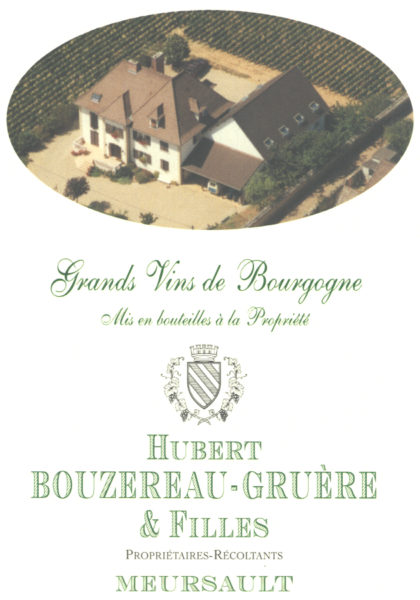
The Estate
Domaine Hubert Bouzereau Gruère is a family business, named for the union of two old winemaking families: Hubert Bouzereau in Meursault, and Marie-France Gruère in Chassagne-Montrachet.
Hubert Bouzereau is the 7th generation of winemakers of his family and it was in 1970 that he established his own estate with his wife Marie-France.
Today, two of their daughters have joined them in the family business: Marie-Laure has been working at the Domaine since 1995 and Marie-Anne since 1999.
In 2001, the daughters partnered with their father and created Domaine Hubert Bouzereau Gruère et Filles. Marie-Laure and Marie-Anne represent the 8th generation of the winemaking family. They are at the head of a 10-hectare estate spread out over 6 communes in the Côte de Beaune, the production of which is three quarters white wine and one quarter red. The Domaine is quite varied and is composed of Grand Cru, Premiers Crus, Villages, and Regional appellations.
Marie-Laure is in charge of administrative duties and marketing, as well as hospitality. Marie-Anne is responsible for vinification, order preparation, receiving clients, and some aspects of marketing. In addition, both women work an equal amount of time in the vineyards.
Hubert is a passionate winemaker, and has transferred his love for and knowledge of the craft of winemaking to his daughters. To this day, he continues to work with great pleasure and care among his vines and in the cellars.
The wines of the Domaine are regularly cited in wine guides such as Guide Hachette, Guide Bettane & Desseauve, Bourgogne Aujourd’hui, la Revue des Vins de France, etc.
Marie-Laure and Marie-Anne stress the importance of the heritage of old vines which constitute the estate. They continually strive to produce well-balanced wines with beautiful minerality and aromatic purity, as well as good acidity in order to lend the wines great finesse.
The two sisters work with the same spirit and respect for tradition and terroir, just like their father.
The Appellations
White Wine
- Meursault-Charmes 1er Cru
- Meursault-Genevrieres 1er Cru
- Meursault “Les Tillets”
- Meursault “Limozin”
- Meursault “Les Grands Charrons”
- Meursault
- Puligny-Montrachet
- Chassagne-Montrachet 1er Cru “Les Chaumées”
- Chassagne-Montrachet “Les Blanchots Dessous”
- Chassagne-Montrachet
- Saint-Aubin 1er Cru “Le Charmois”
- Saint-Aubin 1er Cru “Les Cortons”
- Bourgogne Chardonnay
- Bourgogne Aligoté
Red Wine
- Corton Bressandes Grand Cru
- Meursault
- Chassagne-Montrachet
- Santenay
- Bourgogne Pinot Noir
- Bourgogne Passetoutgrain
The Vines
One of the priorities of the estate is the careful handling of the vines. Pruning is the principal work in the vineyard from the end of autumn throughout the whole of winter.
In spring, work on the vines is more frequent; starting in the month of May and sometimes even at the end of April, debudding begins, followed by the lifting of “les fils”, plowing, and trimming of the vines.
The vines are farmed using sustainable agriculture, however it is necessary to protect the vines from disease and parasites using minimal treatments.
Harvest & Vinification
In September, the harvest is hand-picked for a period of 9-10 days. The pressing is pneumatic, and vinification is done using traditional methods. The wines are aged in a vaulted cellar for 12-18 months in oak barrels of about 20-15% new wood. The white wines undergo bâtonnage until the month of March.
The red grapes are picked in bunches and undergo a cold pre-fermentation maceration. Fermentation lasts between 14-18 days.
The wine is then bottled on the property after which it is sold; the majority of the wine is exported to individual clients, wine shops, and restaurants.
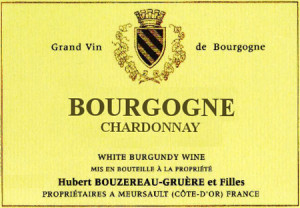
Bourgogne Blanc
Location: This wine is produced from vineyards planted in Meursault
Grape Variety: 100% Chardonnay
Harvest: Manual
Vinification: Pneumatic pressing, débourbage, alcoholic fermentation without yeast, malolactic fermentation
Aging: Maturation in oak barrels with 20-25% new wood on the lees for 1 year with regular bâtonnage
Tasting Notes: Fine minerality and complex palate. Nutty aromas and notes of vanilla, lemon, and peach with a flinty edge.
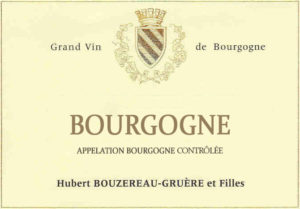
Bourgogne Rouge
Location: This wine comes from a plot of vines located behind the Estate called “Les Pelles.”
Grape Variety: 100% Pinot Noir
Production Area: 0.26 hectares
Yield: 50 hl/ha
First Planting: 1959
Harvest: Manual
Vinification: Traditional vinification. Pneumatic pressing, racking, fermentation without adding yeast, malolactic fermentation. The wine is aged in 20-30% new oak barrels in the cellar for 12 months. The wine is then bottled on the property within 12 to 18 months depending on the vintage and will wait a few months before being marketed.
Tasting Notes: Brilliant ruby color. The nose is pleasant and fruity with elegant notes of red fruit. Very enjoyable when consumed young, but also has fantastic aging potential.
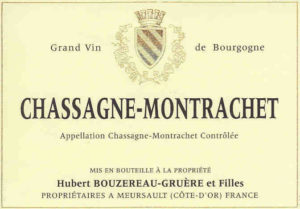
Chassagne-Montrachet Blanc
Soil: Clay limestone
Grape Variety: 100% Chardonnay
Year of First Planting: 2003
Production Area: 0.54 hectares
Yield: 46 hl/ha
Harvest: Manual
Vinification: Pneumatic pressing; débourbage; alcoholic fermentation without yeasts; malolactic fermentation
Aging: In oak barrels (25% new wood). Aging on the lees with regular bâtonnage. Bottled on the estate.
Cellaring Potential: 5-8 years
Tasting Notes: Generous structure, fragrant, elegant, and precise. This young wine is delightfully fruity and quite pleasant to drink while young.
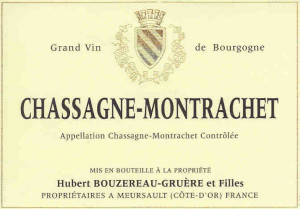
Chassagne-Montrachet Rouge
Location: This wine is produced from several different plots of vines in Chassagne: Les Bouchons de Corvée, Le Poirier du Clos, and La Corvée
Grape Variety: 100% Pinot Noir
Production Area: 0.66 hectares
Average Yield: 48 hl/ha
First Planting: 1971- 1972
Terroir: Reddish and stony soil, brown and limestone
Harvest: Manual into cases
Vinification: Traditional; aging in oak barrels for 18 months (20% new wood). Bottled on the estate
Tasting Notes: Brilliant ruby color. The nose is pleasant and fruity with elegant notes of red fruit. Very enjoyable when consumed young, but also has fantastic aging potential.
Cellaring Potential: 10-12 years
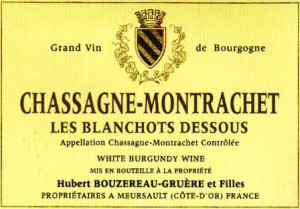
Chassagne-Montrachet Les Blanchots Dessous
Location: This plot is particularly well situated along the extension of Grands Crus Criots Bâtards Montrachet
Grape Variety: 100% Chardonnay
Year of First Planting: 1972
Production Area: 0.23 hectares
Average Yield: 48 hl/ha
Soil: Pebbly limestone
Harvest: Manual
Vinification: Pneumatic pressing, débourbage, alcoholic fermentation without yeast, malolactic fermentation
Aging: Maturation in oak barrels with 30% new wood on the lees for 1 year with regular bâtonnage
Tasting Notes: The noble terroir is beautifully expressed in this wine. Green reflections, with fragrances of white flowers, honeysuckle, and chamomile. The palate expresses white peach. Ripe fruit notes and a lovely minerality give this wine good balance.
Cellaring Potential: 8-10+ years
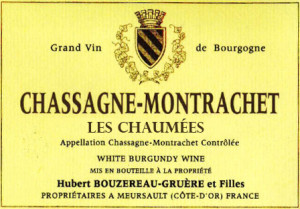
Chassagne-Montrachet 1er Cru Les Chaumées
Location: The vines are situated on a slope facing northeast, to the left of the quarry of Chassagne which is celebrated for its marble stone
Grape Variety: 100% Chardonnay
First Planting: 1975
Production Area: 0.5 hectares
Average Yield: Between 48-50 hl/ha
Harvest: Manual
Terroir: Pebbly limestone soil
Vinification: Pneumatic pressing, débourbage, alcoholic fermentation without yeast, malolactic fermentation
Aging: In oak barrels (30% new wood) sur lies with regular bâtonnages. Bottled at the estate
Cellaring Potential: 8-10 years or more
Tasting Notes: Pale yellow color with shades of green. Aromas of citrus and exotic fruit, as well as a lovely minerality and aromatic purity
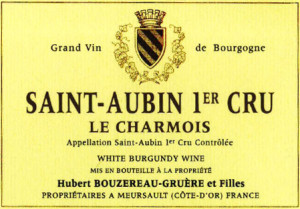
Saint-Aubin 1er Cru Le Charmois
Location: This plot of southern-facing vines is neighbor to the appellation of Chassagne Montrachet 1er Cru les Chaumées and is one of the best Premier Crus of Saint Aubin
Grape Variety: 100% Chardonnay
Year of First Planting: 1972-1975
Production Area: 0.33 hectares
Average Yield: 48-50 hl/ha
Soil: White clay and limestone
Harvest: Manual
Vinification: Pneumatic pressing, débourbage, alcoholic fermentation without yeast, malolactic fermentation
Aging: Maturation in oak barrels with 25% new wood on the lees for 1 year with regular bâtonnage
Tasting Notes: Beautiful pale color and a lemony nose, typical of Saint Aubin Premier Cru. The roundness, consistency, and the freshness of the citrus notes give good balance to this wine.
Cellaring Potential: 8-10 years
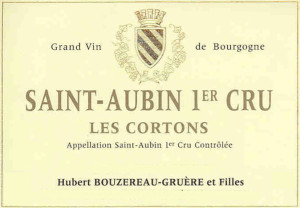
Saint-Aubin 1er Cru Les Cortons
Location: This plot is situated on a marked slope, behind Le Montrachet, on the opposite side of Saint Aubin 1er Cru Le Charmois, and above the hamlet of Gamay. Oriented to the south-southwest, this Saint Aubin 1er Cru could equally be called Saint Aubin 1er Cru “En Remilly.”
Grape Variety: 100% Chardonnay
Year of First Planting: 1988
Production Area: 0.28 hectares
Average Yield: 50 hl/ha
Soil: White clay and limestone
Harvest: Manual
Vinification: Pneumatic pressing, débourbage, alcoholic fermentation without yeast, malolactic fermentation
Aging: Maturation in oak barrels with 25% new wood on the lees for 1 year with regular bâtonnage
Tasting Notes: Brilliant appearance with shades of gold. This wine has much freshness and finesse, and a fluid body. Refined and elegant.
Cellaring Potential: 8-10 years
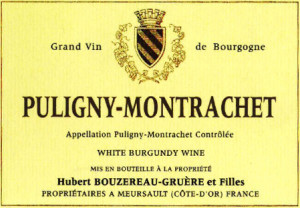
Puligny-Montrachet
Location: A parcel of land called “Les Houillères” located on the edge of Chassagne-Montrachet
Grape Variety: 100% Chardonnay
Year of First Planting: 1972
Production Area: 0.5 hectares
Average Yield: 50 hl/ha
Soil: Clay limestone
Harvest: Manual
Vinification: Pneumatic pressing, débourbage, alcoholic fermentation without yeast, malolactic fermentation
Aging: Maturation in oak barrels with 25% new wood on the lees for 1 year with regular bâtonnage
Tasting Notes: Much freshness and finesse; the nose expresses acacia, hazelnut, toasted almond, vanilla, and white pepper.
Cellaring Potential: 5-8 years
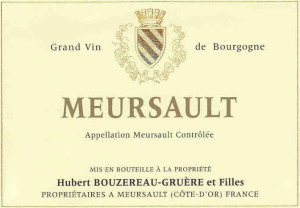
Meursault Blanc
Location: This wine is produced from a plot of wines behind the domaine called “Les Pelles.”
Grape Variety: 100% Chardonnay
Production Area: 0.26 hectares
Year of First Planting: 1959
Average Yield: 50 hl/ha
Soil: Clay limestone
Harvest: Manual
Vinification: Traditional
Aging: Maturation in oak barrels for 11-12 months (20-30% new wood)
Tasting Notes: Very heady bouquet, with aromas of almond, honey, and hot, crusty bread-beautiful aromatic complexity typical of the vintage. On the palate, the wine has an abundant richness which verges on unctuousness, and has notes of ripe and dried fruit (such as apricots). Vivacious with great length; this is a very elegant wine.
Cellaring Potential: 5-10 years
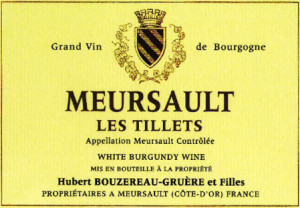
Meursault Les Tillets
Location: This wine is produced from 2 plots situated one below the other on the hills of Meursault
Grape Variety: 100% Chardonnay
Production Area: 0.83 hectares
Year of First Planting: 1961
Average Yield: 50 hl/ha
Soil: Limestone & marl
Harvest: Manual
Vinification: Pneumatic pressing, débourbage, alcoholic fermentation without yeast, malolactic fermentation
Aging: Maturation in oak barrels with 25% new wood on the lees for 1 year with regular bâtonnage
Tasting Notes: This wine has beautiful minerality which awakens the taste buds; notes of grapefruit and lemon are present. The oak is present but only slightly so, and pairs delicately with the bouquet of the wine.
Cellaring Potential: 5-10 years
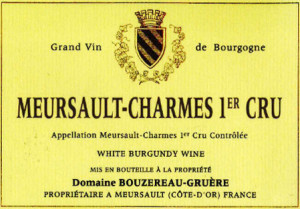
Meursault-Charmes 1er Cru
Location: Meursault-Charmes is one of the most beautiful Premier Crus of Meursault. This wine is produced from 2 plots: Charmes Dessus and Charmes Dessous. The vines planted in Charmes Dessus bring a minerality and vivacity to the resulting wine, whereas the Charmes Dessous vines bring fruitiness and good concentration. The blending of these two plots results in a very well-balanced wine with superb aromatic complexity.
Grape Variety: 100% Chardonnay
Production Area: 0.6 hectares (Meursault Charmes Dessus-0.3 hectares; Meursault Charmes Dessous-0.3 hectares)
Year of First Planting: 1959
Average Yield: 45-48 hl/ha
Soil: Stoney clay
Harvest: Manual
Vinification: Pneumatic pressing, débourbage, alcoholic fermentation without yeast, malolactic fermentation
Aging: Maturation in oak barrels with 30% new wood on the lees for 1 year with regular bâtonnage
Tasting Notes: Very elegant yet direct wine with aromas of citrus, white flowers, and a light minerality. Good length and superb balance, with finesse and richness on the palate. This wine’s purity and elegance distinguishes it as one of the great wines of Meursault.
Cellaring Potential: 10+ years
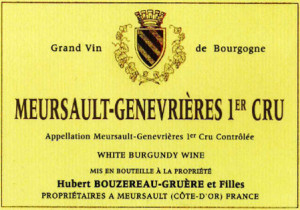
Meursault-Genevrières 1er Cru
Location: This wine is produced from 4 rows of vines that the Bouzereau family owns in the prestigious Premier Cru Meursault-Genevrières, located in the south of Meursault and directly above the climats of Les Perrieres and Les Charmes
Grape Variety: 100% Chardonnay
Average Age of Vines: 60 years old
Annual Production: 50-60 cases; production is extremely limited
Harvest: Manual
Vinification: Pneumatic pressing, débourbage, alcoholic fermentation without yeast, malolactic fermentation
Aging: Maturation in oak barrels with 40% new wood on the lees for 1 year with regular bâtonnage
Tasting Notes: The generosity of the attack is followed by a refined palate with elegant tension. Luscious notes of honey, toasted nuts, and butterscotch.
Cellaring Potential: 5-8 years
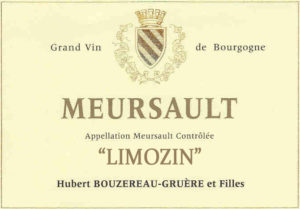
Meursault Limozin
Location: This plot is situated below Meursault Genevrières; it shares one of the best terroirs of the appellation.
Grape Variety: 100% Chardonnay
Year of First Planting: 1969
Production Area: 0.73 hectares
Average Yield: 27 hl/ha
Harvest: Manual
Soil: Clay limestone
Vinification: Pneumatic pressing; débourbage; alcoholic fermentation without yeasts; malolactic fermentation
Aging: In oak barrels (25% new wood). Aging on the lees with regular bâtonnage. Bottled on the estate.
Cellaring Potential: 5-10 years
Tasting Notes: Beautiful, brilliant color. The nose is discreet with notes of grapefruit and young, green lemon. The vivacity of the citrus is also present on the palate and blends perfectly with the woodsy foundation of this wine.
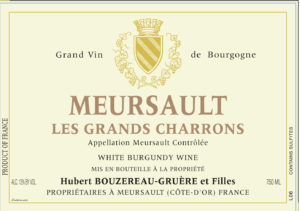
Meursault Les Grands Charrons
Overview: The Meursault Les Grands Charrons is a single-vineyard village wine located just behind the family’s home. The Grand Charrons plot is as close to being Premier Cru as possible. It is situated exactly in line with the major Premier Cru parcels on the slope in Meursault.
Grape Variety: 100% Chardonnay
Average Age of the Vines: 35 years old
Cellaring: 4-6 years
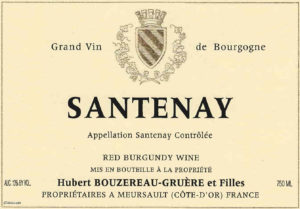
Santenay Rouge
Location: This wine is sourced from 2 different plots in Santenay: Les Hâtes and les Prarons
Soil: Reddish-brown, stony soil with limestone
Grape Variety: 100% Pinot Noir
Production Area: 0.25 hectares
Average Yield: 35 hl/ha
Years of First Planting: 1970-1971
Harvest: Manual
Vinification: Traditional vinification; maturation in oak barrels for 12-18 months (20% new wood). Bottled on the estate.
Tasting Notes: Brilliant ruby color. The bouquet is fragrant with notes of elegant red fruit. Very enjoyable when consumed young, but with great cellaring potential as well.
Cellaring Potential: 8-10 years
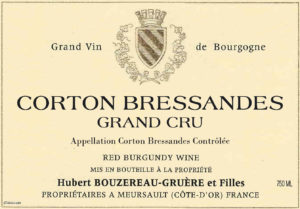
Corton Bressandes Grand Cru
Location: This Grand Cru plot, situated in the commune of Aloxe Corton, was purchased by Hubert Bouzereau in 1971. The vines are planted on the hill of Cortons about 15 kilometers from Meursault. The winemaker is proud to vinify a Grand Cru rouge in Meursault, at the source of the white Grand Vins of Côte de Beaune.
Grape Variety: Pinot Noir
Production Area: 0.14 hectares
Yield: 40 hl/ha
First Planting: 1972
Terroir: Gently sloping plot with reddish-brown, limestone rocky soil. Rich in marl and potash.
Harvest: The grapes are picked manually and placed into boxes
Vinification: Traditional methods
Aging: In oak barrels for 18 months (30% new wood). Bottled at the domaine.
Tasting Notes: Deep, garnet red color. Pleasantly fruity on the nose, with notes of ripe black cherries and vanilla on the palate.
Serving Suggestion: To be consumed immediately or can be cellared for 12-20 years.


